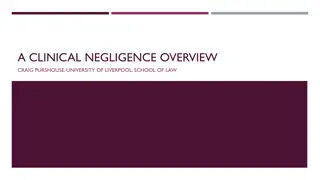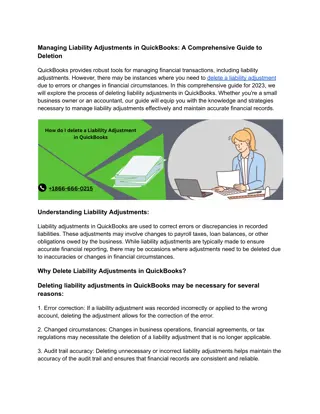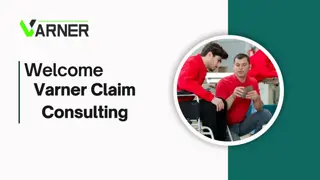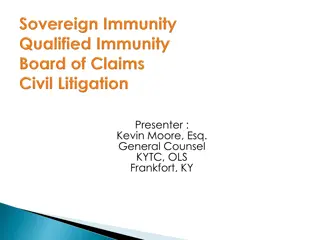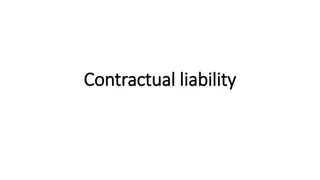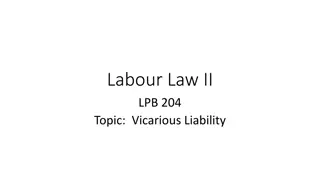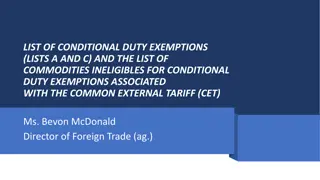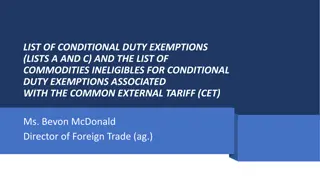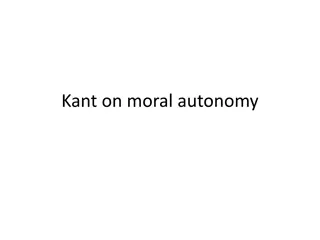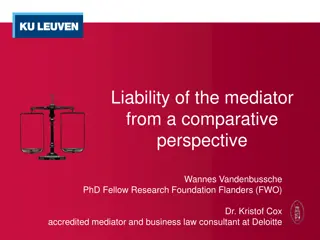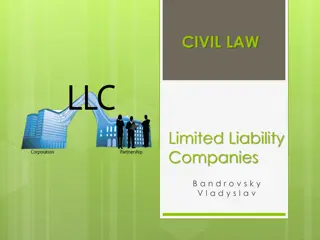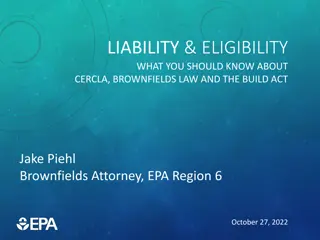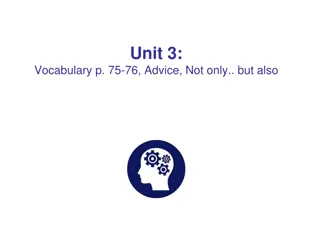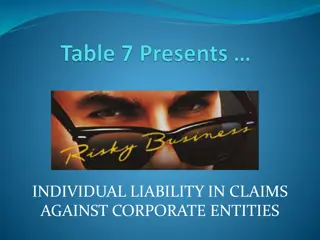Principles of Duty of Care and Civil Liability Act 2002 Explained
Understand the duty of care in legal claims, with insights from cases like Adeels Place v. Moubarak and Sullivan v. Moody. Learn practical guidance on pleading duty and explore key principles from the Civil Liability Act 2002, including foreseeability of harm and considerations for negligence.
Download Presentation

Please find below an Image/Link to download the presentation.
The content on the website is provided AS IS for your information and personal use only. It may not be sold, licensed, or shared on other websites without obtaining consent from the author. Download presentation by click this link. If you encounter any issues during the download, it is possible that the publisher has removed the file from their server.
E N D
Presentation Transcript
ANATOMY OF A CLAIM Petros Macarounas Frederick Jordan Chambers
DUTY OF CARE Adeels Place v Moubarak [2009] HCA 48; (2009) 239 CLR 420: Although ss 5B and 5C appear beneath the heading "Duty of care", that heading is apt to mislead. Mamo v Surace [2014] NSWCA 58 at [48] Identification of the duty and its scope is to be determined according to common law principles and not the Civil Liability Act 2002; Ensure duty is pleaded appropriately according to common law principles
DUTY OF CARE Sullivan v Moody [2001] HCA 59; (2001) 207 CLR 562 at [50] (5 justice single judgment): Different classes of case give rise to different problems in determining the existence and nature or scope, of a duty of care. Sometimes the problems may be bound up with the harm suffered by the plaintiff as, for example, where its direct cause is the criminal conduct of some third party. Sometimes they may arise because the defendant is the repository of a statutory power or discretion. Sometimes they may reflect the difficulty of confining the class of persons to whom a duty may be owed within reasonable limits. Sometimes they may concern the need to preserve the coherence of other legal principles, or of a statutory scheme which governs certain conduct or relationships. The relevant problem will then become the focus of attention in a judicial evaluation of the factors which tend for or against a conclusion to be arrived at as a matter of principle
DUTY OF CARE PRACTICAL GUIDANCE First, plead the duty. It is a must; Second, you ought to plead the nature and scope of the duty; Third, thought should be given to what facts give rise to the duty including the nature and scope of the duty. Those facts should be pleaded specifically and separately so that the defendant has to plead to each material fact. Avoid defined terms it makes a denial much easier if the paragraph in which the definition is given is denied.
CIVIL LIABILITY ACT 2002 - SECTION 5B General Principles (1) A person is not negligent in failing to take precautions against a risk of harm unless (a) the risk was foreseeable (that is, it is a risk of which the person knew or ought to have known), and (b) the risk was not insignificant, and (c) in the circumstances, a reasonable person in the person s position would have taken those precautions. (2) In determining whether a reasonable person would have taken precautions against a risk of harm, the court is to consider the following (amongst other relevant things) (a) the probability that the harm would occur if care were not taken, (b) the likely seriousness of the harm, (c) the burden of taking precautions to avoid the risk of harm, (d) the social utility of the activity that creates the risk of harm.
CIVIL LIABILITY ACT 2002 - SECTION 5C Other Principles In proceedings relating to liability for negligence (a) the burden of taking precautions to avoid a risk of harm includes the burden of taking precautions to avoid similar risks of harm for which the person may be responsible, and (b) the fact that a risk of harm could have been avoided by doing something in a different way does not of itself give rise to or affect liability for the way in which the thing was done, and (c) the subsequent taking of action that would (had the action been taken earlier) have avoided a risk of harm does not of itself give rise to or affect liability in respect of the risk and does not of itself constitute an admission of liability in connection with the risk.
RISK OF HARM - GARZO Garzo v Liverpool/Campbelltown Christian School [2012] NSWCA 151 per Basten JA at [7]: Section 5B of the Civil Liability Act 2002 (NSW) requires identification of a risk of harm, against which a person has failed to take precautions. Given its context, the risk must be that which materialized in the case of the injured person seeking to claim in negligence. That is because s 5B is dealing with a breach of duty of care, being the duty of care owed by the defendant to the injured plaintiff.
RISK OF HARM - GARZO Garzo v Liverpool/Campbelltown Christian School [2012] NSWCA 151 per Meagher JA at [22]: To address the questions and considerations in s5B, it is necessary to formulate the plaintiff s claim in a way which takes account of the precautions which it is alleged should have been taken and identifies the risk or risks of harm which the plaintiff alleges eventuated and to which those precautions should have been directed.
RISK OF HARM - UNITING Uniting Church and Australia Property Trust (NSW) v Miller [2015] NSWCA 320 per Leeming JA at [102]ff recognised it was essential to the determination of liability for failure to exercise reasonable care to identify the risk of harm and continued at [103]: Risk and risk of harm recur throughout Pt 1A of the [Civil Liability] Act, including in provisions which set out necessary elements of liability, such as s 5B. Other provisions, such as 5H (obvious risks) and 5I (inherent risks) are not relevant to this appeal , but they illustrate, once again, that the legislation makes liability dependent upon the identification of the risk of harm. (Emphasis Added)
RISK OF HARM - UNITING At [105] Leeming JA considered that each of the sub-paragraphs of s5B must be considered by a court before a defendant is found negligent. s5B(1) contains conditions to liability and s5B(2) contains a list of non-exhaustive but mandatory considerations that the court must have regard to. At [107] Leeming JA cited the words of Meagher JA in Garzo at [22] noted earlier
RISK OF HARM - UNITING At [118] [119] Leeming JA observed: [118] It is clear that the risk is not to be confined to the precise set of circumstances which are alleged to have occurred, although it must encompass those circumstances. It has been said, in my view correctly, that the proper identification of the risk can be difficult, if not problematic :Erickson v Bagley [2015] VSCA 220 at [33]. That is not to say that the problems need be insuperable. [119] It is unrealistic to expect there to be a single canonically right characterisation of the risk of harm. When Gummow J said in Dederer at [59] that it is only through the correct identification of the risk that one can assess what a reasonable response to that risk would be , I do not understand his Honour to have been contending that there was only one correct formulation of the risk of harm, as opposed to emphasising the important fact that achieving the appropriate level of generality or particularity is vital. One clear indication of the fact that there may be a variety of formulations emerges from the fact that trial judges and appellate courts reaching the same result have, on occasion, formulated the risk differently. That is unsurprising; the Act is in very general terms. (Emphasis Added)
RISK OF HARM MENZ V WAGGA WAGGA SHOW SOCIETY [2020] NSWCA 65 Leeming JA (with whom Payne and White JJA agreed) observed the following at [49]: The Civil Liability Act makes the specification of the risk of harm important in every case. That applies at the threshold in every case in which a failure to take reasonable care is alleged, by reason of three mandatory matters in s5B(1) that a plaintiff must establish, and the four matters in s5B(2) which a court is required to consider, all of which are addressed to a risk of harm. Four of the seven matters invoke a risk of harm in terms, while the other three, s5b(1)(c) and s5B(2)(a) and (b), deal with taking precautions against a risk and the consequences of failing to do so, which cannot be assessed without regard to the risk. The importance of identifying a risk of harm has been stressed in, inter alia, Garzo v Liverpool/Campbelltown Christian School [2012] NSWCA 151 at [22]; Port Macquarie Hastings Council v Mooney [2014] NSWCA 156 at [52]; Uniting Church and Australia Property Trust (NSW) v Miller [2015] NSWCA 320 at [102] [107]; Nepean Blue Mountains Local Health District v Starkey [2016] NSWCA 114 at [87]; Fairall v Hobbs [2017] NSWCA 82; 347 ALR 151 at [74] [76] and Coles Supermarkets Australia Pty Limted v Bridge [2018] NSWCA 183 at [20] [22];
RISK OF HARM PRACTICAL STEPS This is very simple- you must plead the risk of harm (Note comments of Garling J at first instance in Garzo). When you take initial instructions from a client your mind should be turning then and there to what the risk of harm is. The identification of the risk of harm THEN permits the consideration of a reasonable response to the risk of harm from a reasonable person in the position of the defendant. Brief early get the pleadings right at the outset. Pleadings are your first piece of advocacy with the court and the insurer.
THE RISK WAS FORESEEABLE This requires either actual or constructive knowledge. It is considered an undemanding test Koehler v Cerebox (Australia) Pty Limited [2005] HCA 15 at [33] and [54]. Note s45 Civil Liability Act 2002 (NSW) for cases involving Roads Authorities and the need to establish Actual Knowledge. If possible to plead a source of actual knowledge, plead it particularly for cases involving s45.
THE RISK WAS NOT INSIGNIFICANT An assessment of the relative probability of the harm occurring judged from the position of a reasonable person in the position of the defendant viewed prospectively: Stojan v Kenway [2009] NSWCA 364 at [136] per McColl JA. The obviousness of the risk, the likelihood of occurrence, the seriousness of its consequences are all factors relevant to this assessment: South Sydney Junior Rugby League Club v Gazis [2016] NSWCA 8 at [89] cited with approval in Rail Corporation New South Wales v Donald; Staff Innovations T/as Bamford Family Trust [2018] NSWCA 82 at [140].
A REASONABLE PERSON IN THE POSITION OF THE DEFENDANT WOULD HAVE TAKEN PRECAUTIONS Considered prospectively: Adeels Place v Moubarak [2009] HCA 48; (2009) 239 CLR 420 at [31] applying Vairy v Wyong Shire Council [2005] HCA 62 (2005) 223 CLR 422 at [126] Duty of care imposes an obligation to exercise reasonable care: it does not impose a duty to prevent potentially harmful conduct RTA v Dederer (2007) 234 CLR 330 at [18] per Gummow J; It is not a weighing of the factors in s5B(2) (a) and (b) against s5B(2)(c) and (d); Waverley Council v Ferreira [2005] NSWCA 418 at [51] it is an evaluative task weighing up all the relevant factors Sibraa v Brown [2012] NSWCA 328 at [74]; The burden of taking precautions is not limited to financial burden and is not narrowly construed New South Wales v Mikhael [2012] NSWCA 338 at [82] Highly fact and duty dependent e.g. commercial premises as opposed to residential premises and common law considerations will often apply eg Jones v Bartlett (2000) 205 CLR 166
CIVIL LIABILITY ACT 2002 - SECTION 5D CAUSATION 5D General principles (1) A determination that negligence caused particular harm comprises the following elements (a) that the negligence was a necessary condition of the occurrence of the harm (factual causation), and (b) that it is appropriate for the scope of the negligent person s liability to extend to the harm so caused (scope of liability). (2) In determining in an exceptional case, in accordance with established principles, whether negligence that cannot be established as a necessary condition of the occurrence of harm should be accepted as establishing factual causation, the court is to consider (amongst other relevant things) whether or not and why responsibility for the harm should be imposed on the negligent party. (3) If it is relevant to the determination of factual causation to determine what the person who suffered harm would have done if the negligent person had not been negligent (a) the matter is to be determined subjectively in the light of all relevant circumstances, subject to paragraph (b), and (b) any statement made by the person after suffering the harm about what he or she would have done is inadmissible except to the extent (if any) that the statement is against his or her interest. (4) For the purpose of determining the scope of liability, the court is to consider (amongst other relevant things) whether or not and why responsibility for the harm should be imposed on the negligent party.
CIVIL LIABILITY ACT 2002 - SECTION 5E CAUSATION - ONUS 5E Onus of proof In proceedings relating to liability for negligence, the plaintiff always bears the onus of proving, on the balance of probabilities, any fact relevant to the issue of causation.
CAUSATION Patrick Stevedores Operations (No 2) Pty Ltd v Hennessy; FBIS International Protective Services (Aust) Pty Ltd v Hennessy [2015] NSWCA 253 per Leeming JA (With whom McColl and Basten JJA agreed): [95] Unlike duty and breach, the inquiry as to causation is wholly retrospective [and] ... seeks to identify what happened and why : Vairy v Wyong Shire Council [2005] HCA 62; 223 CLR 422 at [124];Warth v Lafsky [2014] NSWCA 94; 2014 Aust Torts Rep 82-166 at [61]. Putting to one side s 5D(1)(b) (which was not relied upon), causation is wholly factual and turns on the plaintiff s proof on the balance of probabilities that the failure to take the precaution was a necessary condition of the occurrence of harm:Strong v Woolworths Ltd [2012] HCA 5; 246 CLR 182 at [18];Wallace v Kam [2013] HCA 19; 250 CLR 375 at [14]. [96] Proof of the requisite causal link between those omissions and an occurrence required consideration of the probable course of events had the omissions not occurred: Strong v Woolworths Ltd at [32].
CAUSATION ONUS & EXPERT EVIDENCE Murray v Sheldon Commercial Interiors Pty Ltd [2016] NSWCA 77 Plaintiff alleged he slipped off a ladder covered in dust causing injury. The Court of Appeal (Leeming JA; Payne JA; Schmidt J) observed: [83] It followed that Mr Murray bore the onus of proving, on the balance of probabilities, that the dustiness of the ladder was a necessary condition of his fall, which is to say that but for Sheldon s negligence, he would not have slipped on the ladder. The starting point is some admissible evidence about the two surfaces which interacted: the sole of his shoe and the surface of the step. In this trial there was none.
CAUSATION ONUS & EXPERT EVIDENCE Jackson v McDonald's Australia Ltd [2014] NSWCA 162 [122] The appellant did not call any evidence from persons qualified to express an opinion on the issue of slip resistance of the particular surfaces and the effect that wetness on soles might be expected to have had: compare the plaintiffs in, for example, Cherry v Jaymardo Pty Ltd (above),Glad Retail Cleaning Pty Ltd v Alvarenga (above) and Riley v The Owners - Strata Plan 73817 [2012] NSWCA 410. Nor did the appellant call any expert evidence as to the likely state of a sole of the kind he was wearing after it had traversed a wet area and then a dry area of between one and three metres consisting of the particular surface in fact installed at the top of the stairs. He thus chose to leave an evidentiary vacuum on the issue of, first, the extent to which soles of the particular kind, having encountered wetness on the floor surface, were likely still to be wet at the time of his fall and, second, the propensity of soles of the particular kind, if wet, to cause slipping to a greater degree than if dry when traversing surfaces of the particular kinds. [123] Even taken at its highest, the appellant's evidence cannot support the inference that he asks this court to draw. The appellant's submissions on causation must fail accordingly.
CAUSATION - PRACTICAL MATTERS From a pleading perspective not a great deal of attention is required. The issue is whether expert evidence will be necessary. You will need to give careful consideration to the reasonable precautions that need to be taken, and how you will prove those steps were reasonable. In in slip and fall matters it probably will be if you cannot obtain appropriate concessions from your opponent given the cases discussed. Expert evidence will need to be considered at an early stage given the manner in which the JR runs the list these days.
HALLMARK CONSTRUCTION PTY LTD V BRETT HARFORD [2020] NSWCA 41 Delivery driver self employed via a corporate vehicle. Was injured when he intended to deliver goods to a building site noticed a pallet on the ground at the spot he intended to deliver the goods. He was directed by someone on site to leave the goods in that location without warning of the existence and location of a retention pit. He attempted to move the pallet. Unbeknown to the plaintiff that pallet was covering a 900mm square retention pit that was some 4 metres deep. Damages were agreed at $1.6million. Fagan J at first instance found no contributory negligence. Court of Appeal upheld the finding of no contributory negligence. First, the court noted that in applying CLA s5R the court must consider the harm in fact suffered by the plaintiff to consider the risk of that harm. In this case it was the risk he would fall into a 4 metre concrete pit and suffer a broken pelvis, broken ribs and spinal injuries as opposed to slipping/ tripping on glass/rubble at [27].
HALLMARK CONSTRUCTION PTY LTD V BRETT HARFORD [2020] NSWCA 41 Second, noted the application of s5B and 5C are not easily transposed to contributory negligence. Question in this case was whether the plaintiff ought to have realised it covered an opening as opposed to being discarded [28]. Third, noted that causation issues could arise and whether s5R engages the principles of s5D left open in Coles v Bridge [2018] NSWCA 183 at [31] but declined to settle that issue as it was not determinative in this case [29]. Fourth, care need be taken by a reasonable person in the position of the Plaintiff or the qualified objective test (Boral v Cosmidis (no. 2) [2014] NSWCA 139 [94] in this case the plaintiff ought to be considered to have taken reasonable care as he knew there were retention pits.
HALLMARK CONSTRUCTION PTY LTD V BRETT HARFORD [2020] NSWCA 41 Regarding the liability of the plaintiff s corporate employer the CoA found that Fagan J had conflated what Hartford did in his personal capacity with what the company ought to have done as an employer. The Court considered that there was no breach of duty in this case given that there was nothing to alert a bystander to the presence of a retention it under the pallet. A safe system of work has greater prominence where there is a degree of repetition and where the employer has control of the site/sites where the work occurred. In this case, the site was controlled by third parties and there was no need to identify specific questions about how the task could be undertaken given the various sites and circumstances which might be encountered.
MENZV WAGGA WAGGA SHOW SOCIETY INC [2020] NSWCA 65 Appellant was injured when her horse fell while warming up before a competition at the Wagga Wagga Show in 2012 [1]. The appellant was riding her horse Sonny, warming up before the show [5]. Children who were playing and/or climbing on a fence surrounding the race track made contact with a metal sign on the fence causing a loud noise, startling Sonny [5]. Sonny fell onto his right side causing the appellant to fall off him [5]. The respondent accepted that it had the care, control and management of the show held at the Wagga Wagga Show Ground [1] and it is not in dispute that the appellant sustained serious injuries as a consequence of falling off Sonny and that she continues to suffer psychologically from the accident [5].
MENZV WAGGA WAGGA SHOW SOCIETY INC [2020] NSWCA 65 Issue 1: Whether the primary judge erred in characterising the risk as an obvious risk , and in finding that the appellant was engaged in a dangerous recreational activity, such that s 5L of the Civil Liability Act applied to defeat her claim. The specification of the obvious risk must be sufficiently precise as to capture the harm which resulted from its materialisation on the facts of the particular case [71]. As a result of in s 5L requires a causal connection between the harm and the risk which materialises. As this causal connection can only be satisfied after the risk has materialised, determining the appropriate level of particularity in formulating the risk requires hindsight [72]-[73]. The warm-up should not be separated from the competition, however even if the warm-up were treated as different activity from the competition, the warm-up was still dangerous for the purposes of the defence in s 5L because of the over-present risk of a fall from the horse s unexpected reaction to some stimulus [81]-[88].
MENZV WAGGA WAGGA SHOW SOCIETY INC [2020] NSWCA 65 Issue 2: Whether the primary judge erred in rejecting the expert evidence called by the appellant at trial. The primary judge was correct to exclude the evidence in the report. The report did not explain how the author s opinions derived from her specialised knowledge or explain the reasoning process under lying her conclusions that marshals should have been present and children prevented from being present [105] An expert s opinion should expose their process of reasoning in a way that shows the opinion is based on particular specialised knowledge to comply with s 79 Evidence Act [108]
MENZV WAGGA WAGGA SHOW SOCIETY INC [2020] NSWCA 65 Issue 3: Whether the primary judge erred in finding that the respondent had not breached its duty under s 5B of the Civil Liability Act by failing to station marshals. R.e. reasonable steps a person in the respondent s position would have taken for the purposes of s 5B(1)(c) CLA: the appellant had not established that the respondent had breached its duty of care [128] Where a risk warning is effective for the purposes of s 5M Civil Liability Act no duty of care is owed [125].
BAUER MEDIA PTY LTD V KHEDRLARIAN [2020] NSWCA 288 The respondent (Worker) was employed by a labour hire company (Demand). Demand entered into a contract with the appellant (Bauer) whereby Demand provided to Bauer the services of its employees, including the Worker [35]. Among other things, the Worker was required to lift bundles of magazines repetitively whilst working at Bauer s premises: it was up to the employee how many copies of a magazine they would collect from the shelf at one time [51]. The Worker claims the subject injury took place on 27 February 2011 while lifting a bundle of magazines [36]. The Worker claims that as a result of the failure of both Bauer and Demand to provide her with a safe system of work, she suffers from permanent aggravation of a degenerative disease in her neck, permanent aggravation of rotator cuff pathology in each shoulder, tenosynovitis in her right wrist and carpel tunnel syndrome in her left wrist [34].
BAUER MEDIA PTY LTD V KHEDRLARIAN [2020] NSWCA 288 Expert Evidence was admitted as to the system of work which did not contain accurate information from the plaintiff about the development of her symptoms nor the weight of the goods the plaintiff was handling (30Kg as opposed to no more than 11.5kg). The failure to mirror those aspects of the plaintiff s evidence would either lead to the rejection of the report or the report being of limited weight The report did not contain the precise means of task rotation that would be said to have addressed the risk of harm. The report ought to have been rejected on that basis also. Even with the report admitted there remained no evidence of the precise system of work for job rotation nor was there any suggestion that the physical structures of the workplace were negligently designed. The plaintiff was unsuccessful.
TAPPV AUSTRALIAN BUSHMENS CAMPDRAFT & RODEO ASSOCIATION LTD [2020] NSWCA 263 The appellant competed in a campdraft event run by the Australian Bushmen s Campdraft & Rodeo Association Ltd. Campdrafting is recognised as a sport which involves a participant riding a horse for the purpose of chasing cattle and eventually separating one of the animals from the rest of the herd. The appellant was offered to take her father s place in a campdraft event. The appellant had two successful rides earlier on in the day . Upon taking her father s place in the open campdraft at 5pm, with the horse Xena Lena , which the appellant had experience with, the horse fell over due to its legs sliding on the surface. The appellant subsequently fell off the horse and suffered a significant spinal injury.
TAPPV AUSTRALIAN BUSHMENS CAMPDRAFT & RODEO ASSOCIATION LTD [2020] NSWCA 263 It was submitted that a duty of care would have been breached if the association did not; plough the surface where the comp would take place, stop the comp if the ground became unsafe and/or warn competitors that the surface became unsafe. Whilst it was submitted that there was multiple falls throughout the day, Payne JA determined that due to the evidence being purely based on hindsight the exercise of reasonable care did not involve; stopping the competition, ploughing the surface prior to the accident, or warning the contestants of dangerous conditions. Payne JA dismissed ground 1 of the appeal. Payne JA the appeal relied on the argument that the surface had deteriorated, which presented a significant risk. Payne JA determined that, with reference to the case Singh, the risk identified by the appellant was too particular, the risk must be identified with generality. The risk of falling off the horse in this event was deemed to be an obvious risk to the appellant as she had many years of experience. The deterioration of the surface would have also been an obvious risk as the appellant watched multiple riders fall on that exact same day prior to her accident. Grounds 2 and 3 were rejected by Payne JA. Conversely, McCallum JA referenced the appellant s age (19) and her unawareness of the opportunity to withdraw her entry from the competition as reasons to allow grounds 2 and 3. Previous court was held to have erred in finding that as the workers were volunteers under 60(1) of CLA, the immunity provided to them under s 61 extended to the association themselves. Due to the distinction drawn between a volunteer and community org in s 64, Payne JA deemed that a volunteer can only be classified as a natural person, not an organisation. The ground was allowed, but did not affect outcome of appeal.
DAVIES V WHITEHAVEN COAL MINING LIMITED [2020] NSWCA 219 Mr Davies was operating an LHD vehicle whilst working for Whitehaven. He had spent more than half his time as a worker operating these machines. At some stage before the accident, Whitehaven modified the LHD for a reason which has no clear evidence. Due to these modifications, Mr Davies now had to climb to the top of the machine after refuelling it. It was often wet at the refuelling bay. On the day of the accident, Mr Davies slipped from on top of the LHD and placed all his weight on his left shoulder, causing him to suffer a rotator cuff tear in that shoulder. Mr Davies suffered from multiple complications associated with treating the shoulder injury.
DAVIES V WHITEHAVEN COAL MINING LIMITED [2020] NSWCA 219 McCallum JA notes that the primary judge did not state whether the creation of an unnecessary risk amounted to a breach of duty. Expert witnesses admitted that climbing to the top of the machine entailed a risk of falling. The modification of the vehicle created an unnecessary risk of injury when climbing on top of the LHD. Grounds 1 and 4 were upheld by McCallum JA. Despite the primary Judge declaring that Mr Davies expert did not answer the questions regarding safeguarding to the best of their ability in comparison to Whitehaven s expert, Professor Hebblewhite, McCallum JA disagreed with this view. He found that Hebblewhite s advice relied on the unfound assumption that some form of risk assessment took place. McCallum JA agreed with Mr Davies expert, who proclaimed that the rungs and handholds were not sufficient safeguards. McCallum JA also found that the action that Mr Davies had to complete whilst getting down from the LHD was likened to lowering himself over the edge of a short cliff. Grounds 3 and 5 were upheld due to this climbing manoeuvre being an essential action of the work. McCallum JA rejected Whitehaven s submissions that Mr Davies did something incorrectly at the time of his injury as he had completed the manoeuvre before without injury. The judge found that this reasoning does not constitute as carelessness. The focal task is to decipher what happened in this particular instance. McCallum J concluded that without adequate safeguards, no carelessness could be found.
BEST V ROSAMOND [2020] NSWCA 90 Action for assault brought 3 years 7 months and 8 days after the incident. Appellant knew that he had suffered injury and that it occurred at the fault of the defendant before 7 months 8 days after the accident (section 50D(1)(a) and (b)) Question of whether the appellant knew the injury was sufficiently serious to justify the bringing of an action (Section 50D(1)(c)) Found that was known prior to that date. Appellant had permanent eye damage within a month of the accident Trial Judge (Abadee DCJ) applied Baker-Morrison found the claim was statute barred. Court of Appeal applied it also. Decision was upheld unanimously on appeal.









